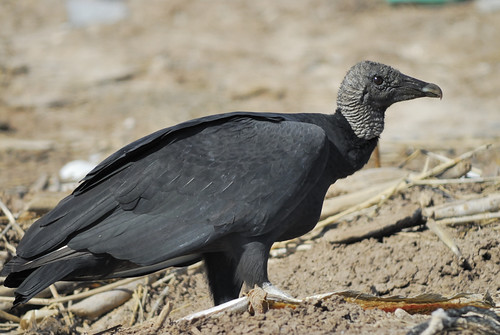tags: American Black Vulture, Coragyps atratus, birds, mystery bird, bird ID quiz
[Mystery birds] American Black Vulture, Coragyps atratus, photographed the Quintana Beach and Jetty area, Texas. [I will identify this bird for you tomorrow]
Image: Joseph Kennedy, 18 November 2008 [larger view].
Nikon D200 1/640s f/8.0 at 1000.0mm iso400.
Please name at least one field mark that supports your identification.
Rick Wright, Managing Director of WINGS Birding Tours Worldwide, writes:
This is clearly a large bird, and readily identified by a number of features visible in our quiz photo. But let's start at the rear, as is our custom, and see if we can tease out some identifying characters that might not have occurred to birders who identified this bird at a glance.
We notice first that the tail is oddly short for the size of the bird. Above the tail we can see some folded primaries -- and the uppermost visible primary shows a bright white shaft. Aha.
The bird's upperparts are quite uniformly sooty black, without conspicuous edgings. The tarsus is pale gray or white. Aha.
We have quite enough already to identify this as a Black Vulture, but the large square head and wrinkly naked neck confirm our analysis: a Turkey Vulture shows a much smaller, pointed head -- pink in adults, gray in young birds -- and an often conspicuous feathered ruff.
Black Vulture is one of those birds that is easy to identify in flight, but birders were relatively slow in working out the characters that permit its identification on the ground or on a telephone pole. Here's a bit of homework: what other species are more difficult, or at least less well-known, when perched than in flight?


Ah, that one's easy. Head color says it all.
I'm thinking Black Vulture? I've never seen one in person, though, only TVs. Black head, no? But my book says immature TVs also have black heads.
In my Peterson, the TV looks like it has fleshiness down further on the beak than the BV. This seems to have fleshiness down a bit further.
On the other hand, the picture of the BV in my book has a shorter tail, and this bird doesn't seem to have much tail.
And I can't see the leg colors.
And both have ranges into Texas.
Still guessing Black Vulture based on head color and tail length. This is why I'm such a lousy birder. :(
And you're right, this is an incredible photo.
It's the Coragyps atratus, a very popular bird in Brasil. :)
Black Vulture - because it's a vulture and it's black.
What Steve Duncan said.
Yes - Black Vulture, and adult, as indicated by the clear gray hide extending well down the throat and less far at the nape. A juvenile would be blacker, while the juvenile TV would not have black wings. About as elegant as a vulture can get; I wish we had 'em around here, but it's all TVs all the time.
Bardiac says, "I've never seen one in person."
You're not from 'round here, are you? ;-)
It's obvious to me that this isn't a TV. Nowhere to plug the antenna in for a start.
Years ago my friend James and I stood high atop the tower at Bowman's Hill, Pennsylvania, watching raptors move north along the Delaware; for some reason, there was also a park ranger up there. At one point James looked out and said, "TV." The ranger looked at us pityingly and said, "Oh no, sir, that's a Turkey Vulture"--and she paused--"and they're very common."
A bald eagle. Get it? hahahahahahaha.
I've been travelling all day.
A short blunt tail and a wee bit of the white on the wingtips is visible, confirming the Black Vulture.
Black Vulture. Sooty face.
Interesting one, because when consulting Birds of North America by Robbins, Bruun, Zim and Singer, the verdict would have been an immature TV, whereas the result based on Sibley would be Black Vulture.
Googling 'Black Vulture' confirms Sibley.
Grrrlie,
when say you'll 'reveal all tomorrow' (about the mystery bird, that is), could you please make that a bit more precise, as in the date?
Just at times I am wildly curious, but the tomorrow seems to never come.
Thanks.
Dear Shonny, A very interesting observation! Tell us more.
r
r
If you have access to Golden Field Guides Birds of North America. A Guide to Field Identification from 1983, you'll see on ppg. 66 -7 the head of an immature TV, which looks like the head of the mature BV.
I like several cross-references when in doubt, so after looking up the vultures in Sibley, Wikipedia became the referee.